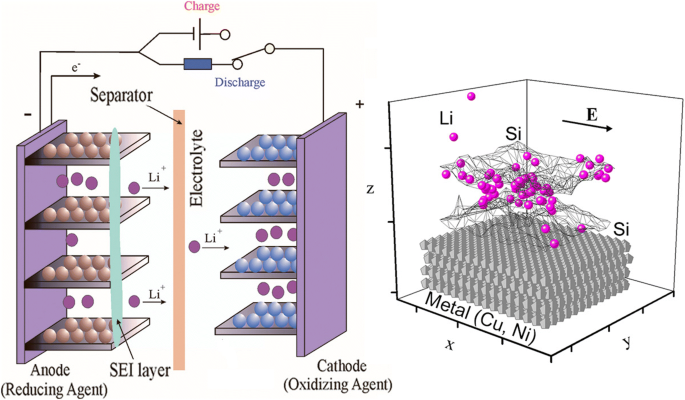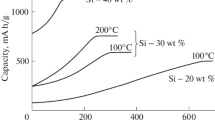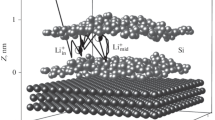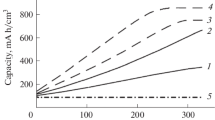Abstract
The functioning of the new anode materials in the form of silicene on copper and nickel substrates was tested by the method of molecular dynamics. It is shown that, two-layer silicene, both ideal and with vacancy defects, on Cu (111) and Ni (111) substrates is more preferable for intercalation of lithium than the corresponding material on Ag (111) substrate. In turn, a higher capacity was found for a lithium-filled silicene channel on a nickel substrate than for a corresponding anode on a copper substrate. In addition, local shear stresses in a functioning silicene anode on a Ni (111) substrate are lower than those on a Cu (111) substrate.
Graphic abstract





Similar content being viewed by others
References
Kamali AR, Fray DJ (2011) Tin-based materials as advanced anode materials for lithium ion batteries: a review. Rev Adv Mater Sci 27:14–24
Dou F, Shi L, Chen G, Zhang D (2019) Silicon/carbon composite anode materials for lithium-ion batteries. Electrochem Energy Rev 2:149–198. https://doi.org/10.1007/s41918-018-00028-w
Ryu J, Hong D, Lee H-W, Park S (2017) Practical considerations of Si-based anodes for lithium-ion battery applications. Nano Res 10(12):3970–4002. https://doi.org/10.1007/s12274-017-1692-2
Salah M, Murphy P, Hall CJ, Francis C, Kerr R, Fabretto M (2019) Pure silicon thin-film anodes for lithium-ion batteries: a review. J Power Sources 414:48–67. https://doi.org/10.1016/j.jpowsour.2018.12.068
Luo X, Lang J, Lv S, Li Z (2018) High performance sandwich structured Si thin film anodes with LiPON coating. Front Mater Sci 12(2):147–155. https://doi.org/10.1007/s11706-018-0416-1
Zamani N, Modarresi-Alam AR, Noroozifar M, Javanbakht M (2019) The improved performance of lithium-ion batteries via the novel electron transport catalytic role of polyaniline (PANI) in PANI/Co3O4–CuO raspberry as new anode material. J Appl Electrochem 49(3):327–340. https://doi.org/10.1007/s10800-019-01286-2
Wang L, Jia J, Wu Y, Niu K (2018) Antimony/reduced graphene oxide composites as advanced anodes for potassium ion batteries. J Appl Electrochem 48(10):1115–1120. https://doi.org/10.1007/s10800-018-1224-0
Kim S-J, Moon S-H, Kim M-C, So J-Y, Han S-B, Kwak D-H, Bae W-G, Park K-W (2018) Micro-patterned 3D Si electrodes fabricated using an imprinting process for high-performance lithium-ion batteries. J Appl Electrochem 48(9):1057–1068. https://doi.org/10.1007/s10800-018-1234-y
Li WG, Xu XB, Liu C, Tekell MC, Ning J, Guo JH, Zhang JC, Fan DL (2017) Ultralight and binder-free all-solid-state flexible supercapacitors for powering wearable strain sensors. Adv Funct Mater 27:1702738. https://doi.org/10.1002/adfm.201702738
Lu J, Chen Z, Pan F, Cui Y, Amine K (2018) High-performance anode materials for rechargeable lithium-ion batteries. Electrochem Energy Rev 1:35–53. https://doi.org/10.1007/s41918-018-0001-4
Balogun MS, Zeng YX, Qiu WT, Luo Y, Onasanya A, Olaniyi TK, Tong YX (2016) Three-dimensional nickel nitride (Ni3N) nanosheets: free standing and flexible electrodes for lithium ion batteries and supercapacitors. J Mater Chem A 4:9844–9849. https://doi.org/10.1039/C6TA02492K
Song Y, Xu JL, Liu XX (2014) Electrochemical anchoring of dual doping polypyrrole on graphene sheets partially exfoliated from graphite foil for high-performance supercapacitor electrode. J Power Sources 249:48–58. https://doi.org/10.1016/j.jpowsour.2013.10.102
Galashev AE, Zaikov YuP (2015) Computer simulation of Li+ ion interaction with a graphene sheet. Rus J Phys Chem A 89:2243–2247. https://doi.org/10.1134/S0036024415120122
Kawahara K, Shirasawa T, Arafune R, Lin C-L, Takahashi T, Kawai M, Takagi N (2014) Determination of atomic positions in silicone on Ag(111) by low-energy electron diffraction. Surf Sci 623:25–28. https://doi.org/10.1016/jsusc2013.12.013
Mazzone AM (2003) Ag deposited onto the (100) surface in silicon studied by density functional theory and classical molecular dynamics. Eur Phys J B 35:517–524. https://doi.org/10.1140/epjb/e2003-00305-2
Galashev AY, Ivanichkina KA (2018) Computer study of atomic mechanisms of intercalation/deintercalation of Li ions in a silicene anode on an Ag (111) substrate. J Electrochem Soc 165:A1788–A1796. https://doi.org/10.1149/2.0751809jes
Galashev AY, Ivanichkina KA (2019) Computer test of a new silicone anode for lithium-ion battery. ChemElectroChem 6:1525–1535. https://doi.org/10.1002/celc.201900119
Plimpton S (1995) Fast parallel algorithms for short-range molecular dynamics. J Comput Phys 117:1–19. https://doi.org/10.1006/jcph.1995.1039
Brostow W, Dussault J-P, Fox BL (1978) Construction of Voronoi polyhedral. J Comput Phys 29:81–92. https://doi.org/10.1016/0021-9991(78)90110-9
Galashev AE, Elshina LA, Muradymov RV (2016) Molecular dynamic study of the mechanism of formation of 2D carbon nanostructures in a solid Al–C nanocomposite grain. Rus J Phys Chem A 90(12):2444–2448. https://doi.org/10.1134/S0036024416120116
Galashev AY (2015) Computer study of the removal of Cu from the graphene surface using Ar clusters. Comput Mater Sci 98:123–128. https://doi.org/10.1016/j.commatsci.2014.11.002
Galashev AY (2013) Atomistic simulations of methane interactions with an atmospheric moisture. J Chem Phys 139:124303. https://doi.org/10.1063/1.4821192
Chavez-Castillo MR, Rodrıguez-Mezab MA, Meza-Montes L (2015) Size, vacancy and temperature effects on Young’s modulus of silicene nanoribbons. RSC Adv 5:96052–96061. https://doi.org/10.1039/C5RA15312C
Acknowledgements
This work was supported by the Russian Science Foundation (the Grant Number 16-13-00061).
Author information
Authors and Affiliations
Corresponding author
Ethics declarations
Conflict of interest
The authors declare that they have no conflicts of interest.
Additional information
Publisher's Note
Springer Nature remains neutral with regard to jurisdictional claims in published maps and institutional affiliations.
Electronic supplementary material
Below is the link to the electronic supplementary material.
Rights and permissions
About this article
Cite this article
Galashev, A.Y., Zaikov, Y.P. New Si–Cu and Si–Ni anode materials for lithium-ion batteries. J Appl Electrochem 49, 1027–1034 (2019). https://doi.org/10.1007/s10800-019-01344-9
Received:
Accepted:
Published:
Issue Date:
DOI: https://doi.org/10.1007/s10800-019-01344-9




